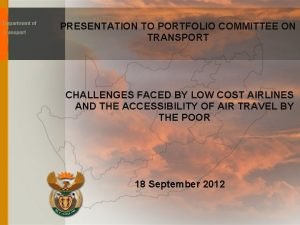Macroeconomics HIVAIDS in the South African Context Gavin



















- Slides: 19

Macroeconomics & HIV/AIDS in the South African Context Gavin George HEARD The Health Economics & HIV/AIDS Research Division

Presentation Structure • Economic Impacts • African Context • Specifically South African • Macro Consequences of HIV / AIDS • Policy Constraints & Pro-Poor Policy • HIV/AIDS Financing: The African Lesson • Conclusions • Final Thoughts

Economic Impact of the HIV epidemic in developing countries Three channels for impacting the economy • Direct costs AIDS treatment (including opportunistic diseases) reduction in savings lower accumulation of capital. • Indirect costs (short term) AIDS invalidity reduction in labour participation. • Deferred indirect costs (long term) AIDS Alteration of the long-term choices of the agents (households and firms) lower investment in physical & ‘human capital’ (education, knowledge, know-how)

AIDS: In Africa • Weakening institutional capacity (loss of educated • • professionals/civil servants) Threatening food security (knowledge transfer for farming) Weakening educational system (loss of teachers) Exacerbating poverty (loss of breadwinners) Swamping medical system Orphans/street children and extended family burdens Reduces life expectancy Impacting economic growth

Drop in labor force will have an impact on economies Source: “Impact of AIDS, ” United Nations Secretariat, Population Division

South African Context: The Impact of HIV/AIDS on Economic Activity In considering how to analyze the macro impacts of HIV/AIDS, there are several salient features of the AIDS epidemic that are likely to have substantial economic implications: • · AIDS tends to strike young adults. According to the data presented by ING Barings (1999), most AIDS-related deaths are likely to occur in the 25 to 45 year age cohort. As a result, AIDS not only reduces life expectancy and the rate of population growth, it will also increase the burden on the working age population, who will be required to care for the young and the sick. 1 • · AIDS is very slow moving. The median span between infection and death is estimated at 8 -10 years (based on the medical technologies currently available in South Africa). During much of this period, the HIV positive individual may experience relatively few direct symptoms, and employment and productivity may be only marginally affected. But with the gradual onset of AIDS (usually during the last 2 years), HIV positive individuals are likely to have declining labor productivity, and to incur increasing and substantial medical costs over the period. • · Infection rates differ by skill class. Analysis in the ING Barings report (1999) suggests that semiskilled and unskilled workers exhibit a peak infection rate nearly three times the rate for highly skilled workers (these results are based largely on the different racial and age composition of the skill classes). Given these differentials in skill-based infection rates, and the current factor endowments in the economy (abundance of unskilled labor, scarcity of skilled labor) the AIDS epidemic will impact factor demands (for both labor and capital) and relative factor returns. These features of the AIDS epidemic will combine and interact with South Africa’s economic structure to affect wages, income distribution, savings rates and other economic variables.

Macro Consequences of HIV / AIDS • The Macroeconomic Impact of HIV / AIDS, Markus Haacker (ed. ) brings together research done by IMF, World Bank, UNAIDS, ILO, CGD, LSE etc. – Devastating social and microeconomic consequences. But equally devastating macroeconomic consequences. – Through mortality and morbidity in most productive segment of population, economic growth likely to be reduced. – Production costs may increase, eroding competitiveness and deterring investment. – Possible adverse consequences on human capital formation (orphaned children or sick parents), and hence future growth. – Civil service (hence implementation capacity and public services) can be devastated. – Tax revenues may fall as economic growth slows, while public health expenditures rise, creating fiscal burden.

Context Macroeconomic policy constraints = - Control inflation Avoid large-scale public deficit Limit long term dependence on external donor financing Opportunity costs of AIDS programmes for other poverty reduction strategies Ultimate goal of growth promotion and Poverty Alleviation?

Pro-poor growth policies • Capacity, opportunity, empowerment, security – – – Investment in education, health, sanitation Infrastructure Financial services Land tenure Agricultural research and extension Red tape – barriers facing MSMEs (micro, small and medium enterprises) – Labor-intensive manufacturing – Safety nets (affordability? ) – Be Careful not to create a dependancy (Child & disability Grants) – Participation, consultation, governance

Role for Macroeconomic Policy • Macroeconomic stability growth • Macroeconomic instability vulnerability • Policy implications – Fiscal policy and debt management – Monetary policy – Exchange rate policy – Financial market policy • Mobilization of financing for poverty reduction – Obligations of international community – Trend towards aid selectivity/conditionality Debt Relief & International Subsidy Priorities will help!



HIV/AIDS Financing: The African Lesson • The budget is considered to be a vote of confidence in government, therefore in South Africa no budget has been turned down by parliament. However in South Africa, budgetary debate is stifled by the absolute majority of the leading party’s vote.

HIV/AIDS Financing: The African Lesson cont. • Advocacy campaigns need to be built around budgetary resource tracking, • • to avoid the problem of government’s using the excuse that they don’t have the money. Donors allocate certain amounts to HIV/AIDS outside of their own countries; there should be a way for sovereign governments to ensure that these funds do not impact on their sovereignty. Is there any government in SSA that is able to match donor funding toward their health sectors? And if/when these donor organisations leave, many of these sectors programs will not be sustainable. In South Africa, the government has centralised the donor resources and planning, in order to know what donors are doing within the country. This is done in order to ensure that when donor programs and funding are withdrawn or come to an end that the government can take them over if they have been successful. Financial dumping occurs when the government realise that they have not spent their budgets for a financial period and it is offloaded on donors who are unable to manage these funds in such a short time, this can lead to mismanagement and corruption.

HIV/AIDS Financing: The African Lesson cont. • There are many players who are involved in the budget process, it is • • important to pool the correct skills when costing, in order to ensure that the budgets are able to meet the plans and priorities going forward. Costing should be part of a country’s national strategic plan, they provide the framework for a budgetary plan going forward, and allow a country to access and allocate funding appropriately. How do you relate budget outcomes to a specific budget, for e. g. HIV prevalence and the health budget? This should not matter, if a country has a holistic approach or overarching integrated national strategy, but it raises an important issue about the contribution of specific and non-specific budget allocations to meeting a particular target like a reduction of HIV prevalence. The equitable share formula is used in South Africa to ensure that the budget is distributed according to the needs of the broader society. Refugees are not properly accounted for in the budgetary process, they are often unable to access the health care system until they achieve legal refugee status. Even though there are international conventions that guarantee the ‘protection’ of refugees in SA, this does not seem to be happening here.

HIV/AIDS Financing: The African Lesson cont • Is it possible for civil society to be involved in the budgetary process? Although there • • • should be more openness in SA With respect to the budget, it does not really happen, civil society are only invited to comment on the budget when it has already been finalised. Are there any weights or indicators in order to determine how much of the budget is effectively targeting HIV prevention/management? No, it is very difficult to determine. Accountability – in some African countries, there is usually only a one way stream of accountability from government to the donors, but not from government to the public. This is why civil society is so important in ensuring that the government are held accountable for their actions. The auditor general should be protected by law from the influence of government. The findings made, should also be widely disseminated into the public domain. Governments must be held accountable and their performance monitored with respect to the signing of international/regional agreements. For example the issue of the South African health minister and the Abuja declaration to committing 15% of the health budget to HIV/AIDS, where the health minister is denying the fact that this agreement was signed. How do I link my rights, to my health? Health is definitely an intersectoral issue; all ministries should be working toward ensuring that their population are able to attain good health.

Concluding remarks

Challenges ahead • Tracking resource use at the country level – Earmarked funds for HIV/AIDS – Public subsidies through the service delivery network – Linking to programmatic indicators • Building national systems to track performance • Timeliness trade offs

Additional Thoughts • Where are the studies looking at the Macroeconomic impacts of other diseases? – Is there too much focus on AIDS? – WAR (civil unrest)?
 Drakensberg mountains map
Drakensberg mountains map National archives and records service
National archives and records service Sacap architectural compliance certificate
Sacap architectural compliance certificate South african air quality information system
South african air quality information system South african council for natural scientific professions
South african council for natural scientific professions Apartheid
Apartheid South african freedom charter pdf
South african freedom charter pdf Safi furniture
Safi furniture South african principals association
South african principals association South african bont tick
South african bont tick South african tax
South african tax South african journal of botany impact factor
South african journal of botany impact factor Southern african transport conference
Southern african transport conference South african transport conference
South african transport conference South african tax
South african tax Hamilton the illiterate surgeon
Hamilton the illiterate surgeon Gavin is designing a kite
Gavin is designing a kite Gavin kearns
Gavin kearns Ending gavin ewart
Ending gavin ewart Tim greenfield
Tim greenfield





































